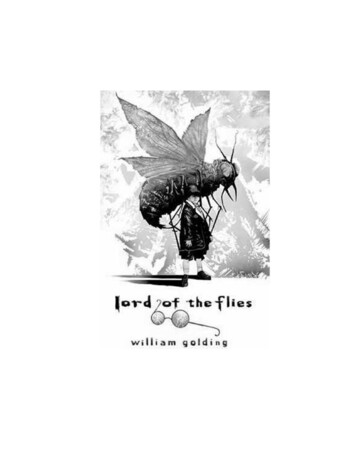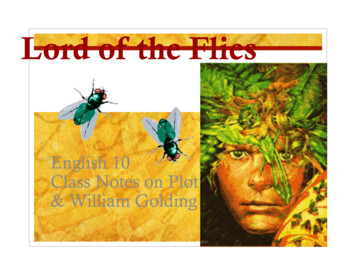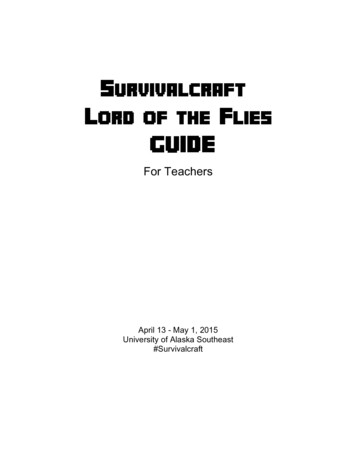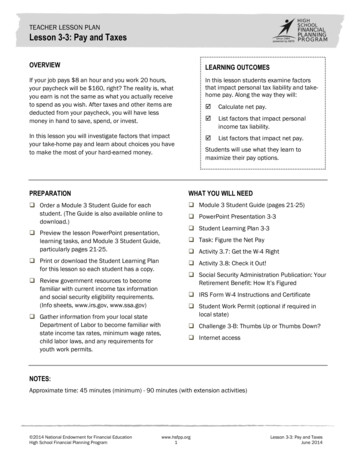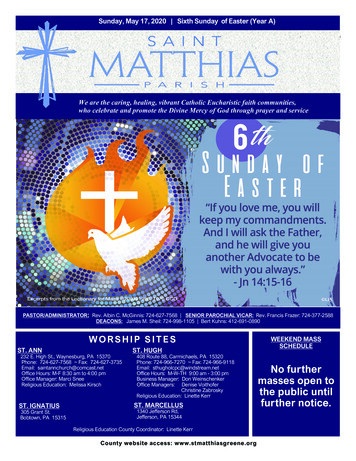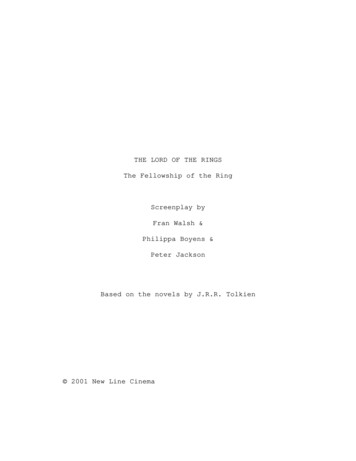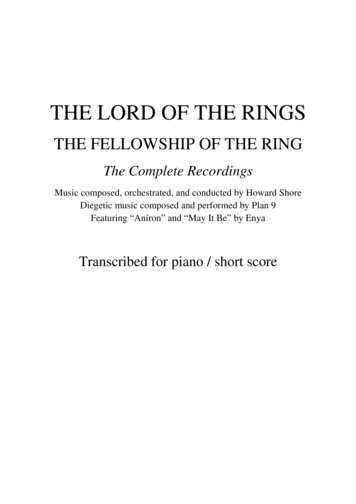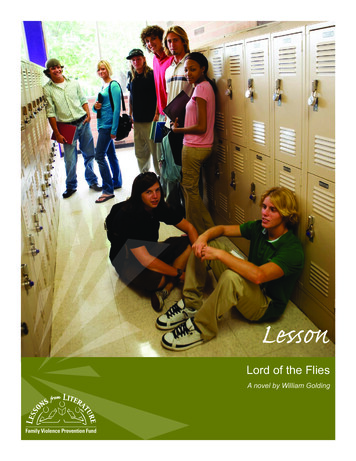
Transcription
LessonLord of the FliesA novel by William GoldingLESSONSfromPreventionLITERATUREFamily ViolenceFundFamily Violence Prevention Fund18www.lessonsfromliterature.org
Lesson: Lord of the FliesOverviewApproximate Time: 3 Weeks (daily 55-minute sessions)In the following unit, students will explore the themes ofpower, control, abuse and respect between the characters inthe novel Lord of the Flies. The terms “power” and “control”refer to how power in an intimate relationship or betweenpeers can be used, either positively or negatively, to controlor influence another person.Learning Objectives Identify and describe power and control dynamics betweenthe characters and how their circumstances influence theirbehavior.MaterialsLord of the Flies – one copy of thenovel per student recommendedTeacher PreparationPhotocopy Handouts (see page 31)– one per studentTermsLord of the Flies 1954ISBN 0-399-52920-9 Identify and explain the consequences of physical andverbal abuse. Propose ways in which the principles of respectful behaviorcan help people to have healthier relationships. Create a visual or audio presentation that demonstrates theprinciples of respectful behavior.Power, control, consequences,principles of respectful behavior,equality, exclusion, autonomy(See online section Getting Readyto Teach for term definitions.)English Language Standards Reading comprehension/Critical thinking/Analysis Expression (verbal and written) Language/literary techniques, termsInstructional SequenceOutlined below you’ll find the Lessons from Literaturerecommended instructional sequence for teaching Lordof the Flies. This lesson was designed to be taught as-is orintegrated into your existing lesson plan for this book. Werecommend you tailor this sequence to your own teachingstyle and your students’ abilities and interests.Part I: This section kicks off the lesson with an activity tofamiliarize students with the themes of power, control, abuseand respect.Part II: This section deepens students’ understanding of power,control, abuse and respect after they’ve had the opportunity toexplore these themes in Part I.Part III: This section has culminating activities and assessmentopportunities that you can select from to complete this literatureunit. At this point in the lesson, it is assumed that students haveengaged in most or all of the Discussions, along with any otheractivities you’ve taught along the way.LESSONS from LITERATUREFamily Violence Prevention Fund Research skills Technology skills Cultural understanding Active (civic) participationPrint or download the full NCTE Education StandardsChart at www.lessonsfromliterature.org.Discussions: Designed to be integrated throughoutParts II and III of the lesson, this section offersdiscussion topics and activities that addressthemes of power, control, abuse and respect,as students make their way through the reading.These Discussions provide students with multipleopportunities to articulate their ideas, engage indialogue with their peers, and reflect on how theseideas relate to the text and the real world.19www.lessonsfromliterature.org
Lesson: Lord of the FliesPart IPart IUnderstanding Power andControl and Their Impact1 Game set-up: Have students play the “I’m Going to aParty and Bringing ” game. Ask for three volunteersto begin; they will be the leaders. All three leaderswill be told that to attend the party, classmates mustbring an item that has a double consonant in it: eggs,butter, balloons, apples, kittens, etc. Leaders 2 and 3each have an additional rule which they do NOT sharewith other leaders. Here are the rules: Leader 1: Accepts all students who offer a correctitem (double-consonant word) Leader 2: Accepts only students who offer a correctitem and share a common trait, such as eye or haircolor, with this leader (leader decides prior to startingthe game, but doesn’t share with other leaders) Leader 3: Accepts only students who offer a correctitem and are sitting in a particular row or area ofthe classroom (leader decides prior to starting thegame, but doesn’t share with other leaders)2 Game play: Allow the leaders to run the game.Leaders begin by giving classmates examples of thethings they may bring to the party. Leaders shouldNOT tell their classmates the double-consonant rule;classmates have to figure out the secret/pattern.Classmates begin to offer their items, stating: “I’mgoing to a party and bringing .” Leaders maymove students to a different part of the classroom asthey become “admitted” to the party. Allow the gameto run until students have divided themselves up intotwo factions, with some students admitted to the partyand others denied even though they offered a doubleconsonant item.3 Debrief: Ask students (including the leaders) to thinkabout how it felt to be admitted or excluded from the“party.” Use the following questions: How did it feel to be in charge? How did it feel to be able to come to the party? How did it feel to be left out of the party? What happened when certain people could or couldnot get into the party/group? Was leadership challenged? If so, how? What werethe results? In this game, who had power and control? In what ways were power and control used?4 Wrap-up: Remind students that while this was justa game, repeated and intentional exclusion amonggroups and between individuals happens every day.Explain that using power to exclude another individualor group from attending a party may be hurtful, but therepeated and intentional use of power and control toexclude and isolate can be abuse. Tell the class thatthey are going to explore ways that power and controlare used among groups and individuals in the book,Lord of the Flies.5 Homework: Observe the student population in yourschool and the various groups that exist. Look atcharacteristics that define and distinguish each group,such as mannerisms or clothing preferences. Whatdo these groups have in common? In what ways doindividuals behave differently when in a group versusalone? Does each group have a leader? Whatdistinguishes the leader from other group members?Observation research can be conducted in the schoolwhereby students analyze the behavior of their peers.As an alternative, you can also choose to have studentsexamine behavior they witness on TV, in a movie, or inanother form of media.6 In-class follow-up: Introduce and distribute the Powerand Control Wheel/PCW and Respect Wheel/RW(see pages 32–33) to students and ask them toconsider the importance and influence of groups.Discussions (see page 23) can begin once students havecompleted Part I.LESSONS from LITERATUREFamily Violence Prevention Fund20www.lessonsfromliterature.org
Lesson: Lord of the FliesPart IIPart IIDeepening Our Understanding ofPower and Control through LiteratureThe following mock-trial activity can follow thecharacterization activity (Discussions, page 24).1 Mock trial: The following mock-trial activity willchallenge students to think like one of the charactersand respond on his behalf. Divide the students intothree groups: Group Jack: This group should look at the entiretime on the island from Jack’s point of view. Group Ralph: This groups should look at the entiretime on the island from Ralph’s point of view. Group Judges: This group will act as an audienceof judges, and will ask questions of Groups Jack andRalph and pass judgment on them.2 Considering point of view: The groups supportingJack and Ralph should consider the following questionsin order to prepare for questions from the judges: What happened? What events does each boy have firsthandknowledge of? What events did each boy hear about? Which actions will each boy defend the mostemphatically? What will each boy say about the other?3 Preparing to make a judgment: The group acting asjudges should prepare questions for both groups. Inorder to come to a fair judgment, what do the judgesneed to find out? How can they look beyond the boys’personalities and leadership styles to find an accuratedepiction of what happened on the island? Explain thatthe judgment group must create questions that elicitboth objective and subjective answers.4 Wrap-up: In a debriefing discussion, explain to studentsthat even with the unique circumstances the boys facedon the island, there was no excuse for the violence thatoccurred. While Jack and his team became violent towardothers, many characters did not resort to violence. Mostpeople are able to respond to stress, frustration, angerand adversity in ways that aren’t abusive or violent. Usethe RW and invite students to give examples of respectfulways to respond to difficult situations. (For instance:communicating, negotiating and taking responsibility)5 Homework: Write a SEE format letter (Statement,Example, Explanation) to one character that you feelstrongly about. In your letter, assess the character’sbehavior by describing his actions and analyzing hismotivations and intentions. Use the PCW, RW, thecharacterization activity (see page 24) and your ownthoughts.Here’s the letter format: Paragraph 1: Introduce yourself to the characterand give your purpose for writing the letter. Paragraphs 2-4: Describe what you understandabout his actions using specific details from the story.These paragraphs should be very detailed andinclude examples from the text. Paragraph 5/Conclusion: Explain your assessmentby making recommendations to the character. Objective: Facts with no personal feelings (Jack leftthe fire to hunt; Ralph gave a list of rules for boys tofollow on the island; etc.) Subjective: Opinions; the boys’ personal feelings(Jack was acting arrogantly and disrespectfully; Ralphdidn’t have enough sense to understand why meatwas important; etc.)LESSONS from LITERATUREFamily Violence Prevention Fund21www.lessonsfromliterature.org
Lesson: Lord of the FliesPart IIIPart IIIAssessment andCulminating ActivitiesAssessment Opportunities1 What Would You Do?Choose three boys from the island and address thefollowing questions for each: Does this boy contribute in any way to the tragedy onthe island? Explain your viewpoint. Could he have acted to prevent any of the deaths?Why or why not? Explain. In your conclusion, imagine you were one of theseboys, and write about what you might have donedifferently in his situation.2 What If .?Think about how the use of power and control affectedthe outcome of events on the island. Choose one ofthe following scenarios to respond to: Imagine the boys weren’t rescued from the island.What do you think would have been the long-termeffects of Jack’s abusive leadership style? In whatways could respectful behavior have created a morepeaceful society? Why was Piggy excluded and not considered aleader? How could things have been different if theboys had respected Piggy and his opinions?Culminating Activities1 Ad CampaignCreate a commercial (such as a TV skit, radio script,or poster) that addresses abuse or respect. Useexamples from the PCW and RW. Have studentsexplain how abusive or respectful behavior affectsrelationships, individuals and groups. You may wish to refer to www.adcouncil.org orwww.endabuse.org for examples of public serviceannouncements.You may choose to allow students extra class periods todevelop their presentations.2 Code of ConductImagine that you and your friends are faced with achallenge like that confronted by the boys in Lord ofthe Flies. How would you cope and behave on adeserted tropical island? Design a code of conduct tolive by that would teach the knowledge, values andskills you would need to surmount all the challengesyou would face. Use the RW as a reference andconsider the following questions: How would you ensure that your own personalboundaries are upheld? How would you ensure the safety of everyone?LESSONS from LITERATUREFamily Violence Prevention Fund22www.lessonsfromliterature.org
Lesson: Lord of the FliesDiscussionsDiscussionsWeaving Power and Control intothe Central Literature ThemeLord of the Flies is a novel that explores themes ofautonomy and groups, acceptance and fear as motivations,and mechanics and defects of society. After a group ofBritish schoolboys, escaping England during World War II,end up marooned on a tropical island, they attempt toestablish a social order and a plan for being rescued. Thebook follows their attempts at social order and the resultsof those attempts.Essential QuestionsThe following essential questions can help guide classdiscussion throughout the reading of the text: What makes an individual powerful? How does individual power change in relationships withothers? Do individuals control groups, or do groups controlindividuals? How does a society maintain order? Are laws necessary? How do fear and desire for acceptance influence humanbehavior? What are the implications for contemporary society? Does violence create power or control?Facilitating Safe and Respectful Class DiscussionYour students may not be familiar with discussing topics of relationship abuse and violence. If your students need a break from adifficult topic, you can reintroduce an essential question to guide the discussion toward more philosophical and general concepts. You canalso assign dual-entry journals (see Strategies for Supporting Student Learning on page 8) or written reflections for students toexplore their opinions and feelings beyond the discussion.Be aware of the mandatory reporting requirements that apply to you as a teacher, and be prepared to refer a student to the schoolcounselor, a local resource or emergency services, if needed. See Responding to Relationship Abuse on page 39.LESSONS from LITERATUREFamily Violence Prevention Fund23www.lessonsfromliterature.org
Lesson: Lord of the FliesCharacterizationDiscussionsSocietal Expectations and Gender Roles/Social OrderDivide students into groups to complete character analyseson each of the major characters: Ralph, Piggy, Sam and Eric,Jack Merridew, Maurice, Roger and Simon. Students cancomplete this activity throughout the reading of the literatureselection.You may choose tointroduce Being a Boy,by Julius Lester, to kickoff the discussion. Discuss society’s expectations for boys as they grow intoadulthood, considering how expectations differ between cultures and over time. Make a list of society’s expectations for boys as they grow into men. Have studentsrefer to this list as they analyze the characters. Describe each boy’s attributes. Create a CASA chart to document evidence from thetext for the following:— Other Characters’ reactions to the boy— The character’s Actions— The character’s Speech— The Author’s (Golding’s) descriptions of the boy As students work, have them consider what motivates each boy to act the way hedoes. You may have students keep a think aloud journal (see Strategies for SupportingStudent Learning on page 8) to record their thoughts as they move through the work.They may also record observations about the boys related to the PCW and RW. Theymay consider the following guiding questions:— How does the evidence for each boy’s attributes reflect societal views of men?— How do societal views of men influence the amount of power and control each boyhas or is perceived to have by the other boys?Ideas and Events to Consider for Individual CharactersRalph Referring to Simon, “He’s queer. He’s funny.”(chapter 3)Jack Slashing the green candle buds (chapter 1) Hesitating when he lifts his knife to kill the piglet, and hispromise for the next time he meets a pig (chapter 1) Criticizing the boys for their lack of cooperation(chapters 3, 4) Treatment of the littluns (chapter 5) Treatment of the littluns (chapter 5) Overthrowing Ralph’s authority (chapters 7, 8) Demonstrating his hunting prowess (chapter 7) Reaction if someone interferes with him (chapter 10) Waning confidence in himself (chapters 7, 8) Plans for Ralph (chapter 11)Maurice Destroying the littluns’ sand castle (chapter 4)Simon Saying he thinks the “beast” may be inside the boysthemselves (chapter 5)Roger Destroying the littluns’ sand castle (chapter 4) Harassing the young boy named Henry (chapter 4)LESSONS from LITERATUREFamily Violence Prevention Fund24www.lessonsfromliterature.org
Lesson: Lord of the FliesChapters 1, 2DiscussionsThe Acquisition of Power and ControlAs students read, have them keep a dual-entry journal (see Strategies for Supporting StudentLearning on page 8). In class, have students begin the CASA character analysis for Ralph, Piggy,and Jack, the first three characters described at length in the text. After completing the fourelements of the character analysis (see CASA description on page 24), have students considerhow the boys begin to create a society for themselves: Why do they generate the rules they do?Have students use their character analyses to apply the PCW to Ralph, Piggy, and Jack; theyshould consider each boy’s treatment of others, using the following guiding questions: How does each boy use his physical characteristics to influence individuals and the group?Are these actions respectful? How does each boy use his personality traits to influence individuals and the group? Are thesemeasures respectful of others? How successful in controlling others is each of these three boys? How does each boyacquire power? Are these ways respectful?Wrap-up: Based on examining physical and personality traits, what are the different types ofstrength and power? Have students free-write on this topic first, then discuss as a group. Consider how personality characteristics of the three boys affected their acquisition of power.Write a reflection on the similarities and differences between these characteristics and thosevalued in society today.Chapter 3Power and Control, Respect and Acceptance and FearIn this chapter, Ralph and Jack discuss the feelings of the boys on the island. Have studentsthink aloud (see Strategies for Supporting Student Learning on page 8) about thesefeelings as they read, considering the following guiding questions: Why do people choose to join a group? Why do groups choose to accept others into their group? Why do groups choose to reject others from their group? Why do people choose to remain in a group? What are the risks of leaving a group?Wrap-up: Have students free-write about how the boys’ society compares to their own highschool environment or other behavior they have observed, experienced or learned about.Chapter 4Power and Control and ViolenceThe boys on the island seem to have split into two groups: Ralph’s builders and Jack’s hunters.As students read, have them create a dual-entry journal (see Strategies for Supporting StudentLearning on page 8) to address the following guiding question: What do the focus on hunting and the desire to kill a pig reveal about the boys’ understandingof life, violence, power and control?Wrap-up: Have your views about life, violence, power and control changed since the beginningof the book? Discuss.LESSONS from LITERATUREFamily Violence Prevention Fund25www.lessonsfromliterature.org
Lesson: Lord of the FliesChapters 5-8DiscussionsPower and Control and the Mechanics and Defects of Society Simon says, “ maybe there is a beast What I mean is maybe it’s only us.” As they readthese chapters, have students create a dual-entry journal (see Strategies for SupportingStudent Learning on page 8) to address how the boys are the beast, considering their use ofpower and control and using the PCW to help support their answers. The left column willcontain examples of the boys as the beast; the right column will contain connections tothe PCW. Consider the sign from the world of grown-ups in chapter 6. How does this compare/connect towhat happens to the boys on the island? Student answers may include: The men are at war(World War II); the boys are becoming as out of control as the men are. They have learnedthe hunting/killing behaviors from men.Chapters 9-12Power and Control, Violence and Acceptance and Fear Trace either the boys’ treatment of Simon from chapters 1–8 or the boys’ treatment of Piggyfrom chapters 1–11. As students read, have them use a dual-entry journal or annotate the text(see Strategies for Supporting Student Learning on page 8) to guide their reading. The leftcolumn will include treatment examples from the text; the right column will include connectionsto the PCW and consideration of the following guiding questions:— How was each boy treated by individuals and groups? (right-column examples)— Do you think this treatment influenced each boy’s death? (left-column analysis)Wrap-up: Have students write a reflection/response on what the boys’ treatment of Simonand/or Piggy reveals about the use of power and control and the impact of groups.DiscussionsWrap-upExamining the Misuse of Power and Control Have students use a Venn diagram to compare the huntsin chapters 4, 7 and 8 to the accidental murder of Simon inchapter 9, the capture of Samneric in chapter 11, and theintentional murder of Piggy in chapter 12.chapters4, 7, 8— What characteristics do they share?— How and why did intent change?— How does each event connect to the PCW?chapterchapter129chapter11Venn Diagram ExampleLESSONS from LITERATUREFamily Violence Prevention Fund26www.lessonsfromliterature.org
Lord of the Flies. This lesson was designed to be taught as-is or integrated into your existing lesson plan for this book. We recommend you tailor this sequence to your own teaching style and your students’ abilities and interests. Materials. Lord of the Flies – one copy of the novel per
